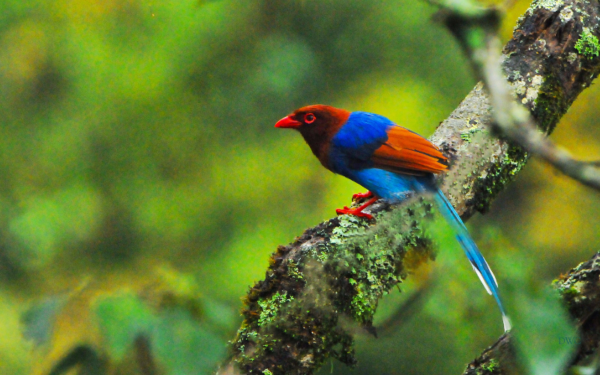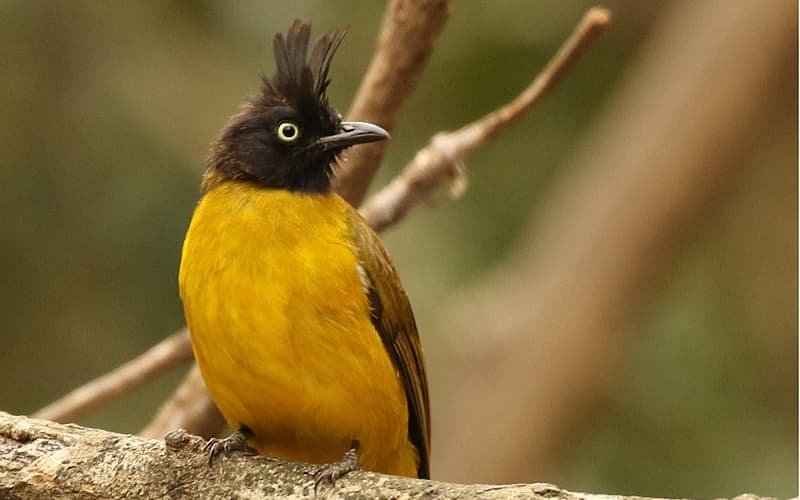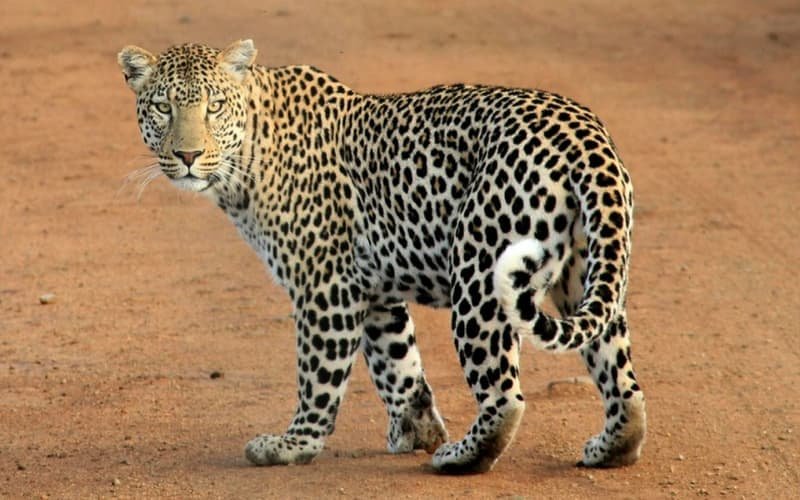About Sri Lanka Blue Magpie
The Sri Lanka Blue Magpie (Urocissa ornata), also known as the Ceylon Magpie, is a stunning, vibrant bird that’s uniquely found only in Sri Lanka. A member of the Corvidae family, this endemic species stands out with its striking blue and chestnut plumage, making it a favorite among birdwatchers and nature enthusiasts. Despite its adaptability, the Sri Lanka Blue Magpie faces significant threats to its survival due to habitat loss. In this article, we delve into the life and habitat of this rare and beautiful bird, and explore the efforts needed to conserve it for future generations.
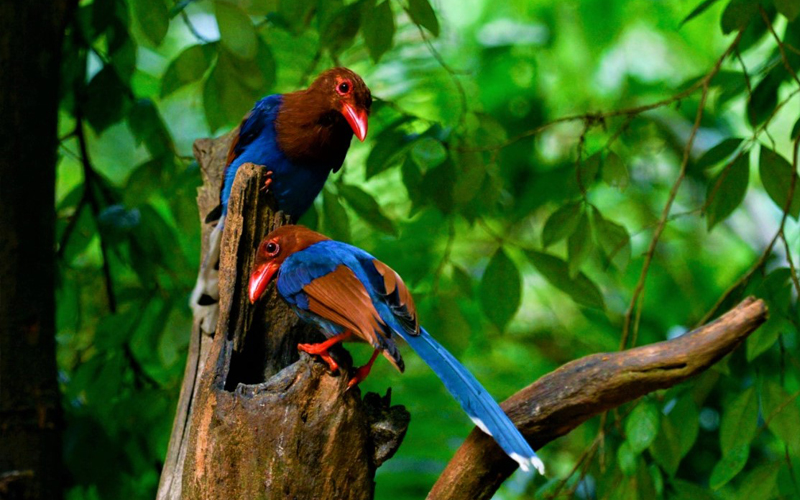
Physical Description of the Sri Lanka Blue Magpie
The Sri Lanka Blue Magpie is a medium-sized bird, measuring between 42-47 cm in length, making it larger than a Mynah but smaller than a crow. Its vibrant blue body is complemented by reddish-brown or chestnut-colored feathers on its head, neck, and wings. The bird’s long, graduated blue tail with a white tip is another distinctive feature. Bright red bill, legs, and feet add to its striking appearance. Juvenile Blue Magpies have duller plumage, with brownish eye rings and a greyer hue to their feathers.
Taxonomy of Blue Magpie
The Sri Lanka Blue Magpie is a member of the order Passeriformes, which is a subfamily of the Corvidae (birds of paradise).
This species is a member of the Urocissa genus of Southeast Asian Magpies, which contains a total of 5 species that have been identified so far. A recent shared ancestor with another genus of Asian Magpies, Cissa, can be traced back to this group. Cissa and Urocisa are both corvid genera that are native to the Oriental region, which is where the diversity of corvid species had its start. New world jays and magpies are descended from a single ancestor that is thousands of years old.
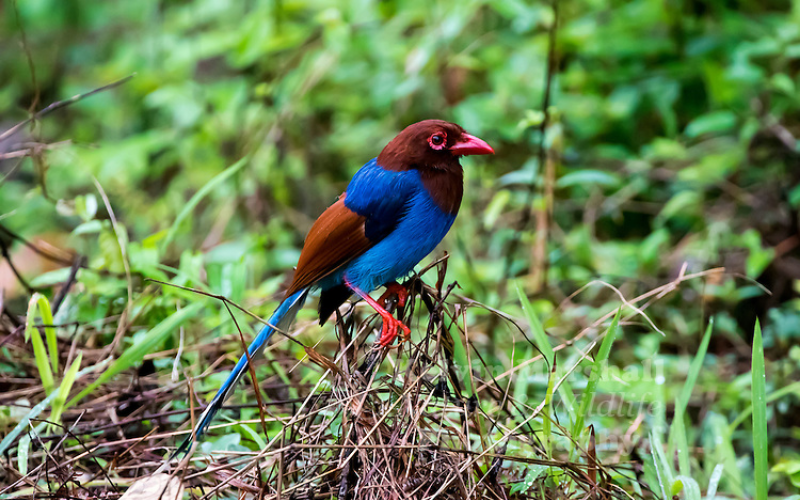
The Blue Magpie’s Natural Habitat in Sri Lanka
Endemic to Sri Lanka, this magnificent bird thrives in the wet zone forests of the island’s southwestern region. The Sri Lanka Blue Magpie is most commonly found at altitudes ranging from 150 to 2150 meters above sea level. Its preferred habitats include tall, undisturbed forests in the highlands, foothills, and adjacent lowlands. The bird avoids disturbed environments like gardens and plantations but can occasionally be spotted in these areas.
Notable Locations to Spot the Blue Magpie:
- Sinharaja Rain Forest (UNESCO World Heritage Site)
- Kitulgala Forest Reserve
- Peak Wilderness Sanctuary
- Hakgala Botanical Gardens
- Morapitiya Forest Reserve
These protected areas offer an ideal setting for the Blue Magpie to forage, nest, and breed in their natural environment.
Behavior and Vocalizations
The Sri Lanka Blue Magpie is highly active and agile, with a preference for dense foliage where it hunts and feeds. Despite its tendency to avoid human-damaged habitats, it is attracted to human presence in certain cases. Visitors to forest areas might witness the bird approaching groups of people, eagerly awaiting food offerings.
The Blue Magpie is known for its varied and complex vocalizations, which include a jingle, chink-chink, and whee-whee. It even mimics the calls of predators like raptors to warn other birds or to mob threats. This remarkable bird has also been observed mimicking the songs and calls of other species, showcasing its intelligence and versatility.
Diet and Feeding Habits
The Sri Lanka Blue Magpie is an omnivorous species, feeding on a variety of foods such as insects, frogs, small lizards, and fruits. They are known for their dexterity and strength, using their powerful legs and feet to cling to branches and even hang upside down while foraging. Some reports suggest that Blue Magpies have been observed removing hairs from caterpillars by rubbing them against trees before swallowing them.
Reproduction and Breeding
Blue Magpies are monogamous and engage in cooperative breeding, with the help of other members of their group to raise the young. Their breeding season typically spans from January to March, with a clutch of 3-5 white eggs speckled with brown. Nests are built on small, slender trees, and both sexes are involved in nest building and feeding, though only the female incubates the eggs.
Diet of Blue Magpie
In order to forage, these birds rely on their powerful legs and feet, and they have been spotted hanging upside down and effortlessly holding down their meal.
A large portion of their diet consists of carnivorous organisms such as insects, frogs, and small lizards, but they have also been observed to ingest fruit, and some findings imply that part of their prey may include the eggs or young of other bird species. Blue magpies have been recorded wiping hairy caterpillars against mossy trees to remove the annoying hairs before swallowing them in Sri Lanka, according to reports.
Reproduction
Sri Lanka blue magpies are monogamous, employ cooperative breeding to raise their young, and can be found in small groups of up to seven birds, each of which has its own territory. They can be found in small flocks of up to seven birds.
The Sri Lanka Blue Magpies have a generation length of 6.7 years, which is relatively short. The breeding season lasts from January to March, and a clutch of three to five eggs, which are white with brown dots on them, is laid in a single clutching. Nests in the shape of cups are constructed on the branches of small, slender trees and lined with soft materials like lichen.
Both sexes contribute to the construction of the nest and feeding of the young, with only the female incubating the eggs.

Conservation Status: A Call to Protect Sri Lanka’s Blue Magpie
The Sri Lanka Blue Magpie is classified as a Vulnerable species by the IUCN Red List, with its population declining due to several threats. Habitat degradation, caused by logging, agriculture, and mining, is the primary risk to its survival. Despite legal protections and conservation efforts, the bird’s habitat continues to be under threat from human activities.
The population size of the Sri Lanka Blue Magpie is estimated to be between 9,500 and 19,500 individuals, but this number is not stable due to ongoing habitat destruction and other pressures. The moratorium on logging in Sri Lanka’s wet zones in the 1990s and efforts by local conservation organizations have helped, but sustainable practices and responsible tourism are key to securing a future for this remarkable bird.
How You Can Help Protect the Blue Magpie
Conserving Sri Lanka’s Blue Magpie requires collective efforts from the government, conservation groups, and the public. Responsible eco-tourism, habitat restoration, and public education about the importance of preserving the Blue Magpie’s habitat are vital. By supporting conservation initiatives and protecting Sri Lanka’s forests, we can help ensure that this beautiful bird continues to thrive in its natural environment.
Conclusion
The Sri Lanka Blue Magpie is not just a beautiful bird but also an important part of the island’s ecosystem, contributing to seed dispersal and pest control. However, with its limited distribution and declining numbers, it faces significant threats. By raising awareness and supporting conservation efforts, we can protect this unique species and ensure that future generations can enjoy its presence in Sri Lanka’s lush, vibrant forests.
Best Tours in Sri Lanka
Discover the best tours in Sri Lanka, where every journey unveils a new wonder. Explore ancient ruins, lush tea plantations, golden beaches, and vibrant wildlife. Experience the magic of this tropical paradise like never before!
Best Hotels
Experience luxury and comfort at the best hotels in Sri Lanka. From serene beachfront resorts to charming hill-country retreats, enjoy world-class hospitality, stunning views, and unforgettable stays tailored to your every need.🛌
Flight Booking
Looking to take off on your next adventure? Book your flights with ease and confidence! Whether it’s a dream vacation, a quick getaway, or a business trip, our flight booking service offers unbeatable deals, flexible options, and seamless convenience. Compare airlines, find the best routes, and secure your tickets in just a few clicks. With 24/7 customer support and exclusive discounts, the skies have never been friendlier. Start your journey today and make every mile memorable! ✈️


